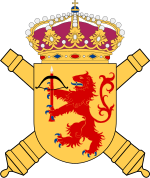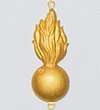Småland Artillery Regiment
The Småland Artillery Regiment (Swedish: Smålands artilleriregemente), designation A 6, was a Swedish Army artillery regiment raised in 1895. It was disbanded in 1985. The regiment was based in Jönköping.
| Småland Artillery Regiment | |
|---|---|
| Smålands artilleriregemente | |
 | |
| Active | 1895–1985 |
| Country | |
| Allegiance | Swedish Armed Forces |
| Branch | Swedish Army |
| Type | Artillery |
| Size | Regiment |
| Part of | 2nd Army Division (1895–1901) 2nd Army Division (1902–1927) Eastern Army Division (1928–1936) I Army Division (1937–1942) I Military District (1942–1966) Southern Military District (1966–1985) |
| Garrison/HQ | Jönköping |
| Patron | Saint Barbara |
| March | "Smålands artilleriregementes marsch" (Rune)[note 1] |
| Anniversaries | 4 December[note 2] |
| Insignia | |
| Branch insignia |  |
Heraldry and traditions
Coat of arms
The coat of arms of Småland Artillery Regiment (A 6) from 1977 to 1985. Blazon: "Or, the provincial badge of Småland, a double-tailed lion rampant gules, armed and langued azure, in the forepaws a crossbow gules, arrowhead argent, bow and string sable. The shield surmounted two gunbarrels of older pattern in saltire or. The gunbarrels may be sable."[2]
Colours, standards and guidons
A standard was presented to the regiment by His Majesty the King Gustaf V on his birthday on 16 June 1938. The hertage of the regiment were passed on by Northern Småland Regiment (I 12) after the disbandment.[3] From 1 July 2000, the traditions of the Småland Artillery Regiment are kept by the Artillery Regiment (A 9).[4]
Commanding officers
FCommanding officers from 1895 to 1985.[5]
- 1895–1898: S G A Geijer
- 1898–1899: A I R de Laval
- 1899–1902: Otto Virgin
- 1902–1902: C V G Grönvall (acting)
- 1902–1905: A O Staël von Holstein
- 1905–1908: A O Staël von Holstein
- 1908–1914: D Hedengren
- 1914–1915: D Hedengren
- 1915–1922: Ludvig Hammarskiöld
- 1922–1927: Bo Tarras-Wahlberg
- 1928–1931: J C Sylvan
- 1931–1932: Per Sylvan
- 1932–1937: S H Thorén
- 1937–1942: J G H Schmiterlöw
- 1942–1949: R N A Årmann
- 1949–1949: Curt Kempff (acting)
- 1949–1951: Hilding Kring
- 1951–1957: I Thorson
- 1957–1957: Nils-Ivar Carlborg (acting)
- 1957–1964: W Lundqvist
- 1964–1970: Sten-Olle Tegmo
- 1970–1973: Claes Carlsten
- 1973–1976: Gösta Gärdin
- 1976–1976: Å Hessler (acting)[6]
- 1976–1980: S Geijer
- 1980–1982: Fredrik Lilliecreutz
- 1982–1985: Lars Carlson
Names, designations and locations
| Name | Translation | From | To | |
|---|---|---|---|---|
| Kungl. Andra Göta artilleriregemente | Royal Second Göta Artillery Regiment | 1894-10-01 | – | 1905-02-01 |
| Kungl. Smålands artilleriregemente | Royal Småland Artillery Regiment | 1905-02-02 | – | 1927-12-31 |
| Kungl. Smålands arméartilleriregemente | Royal Småland Army Artillery Regiment | 1928-01-01 | – | 1942-09-30 |
| Kungl. Smålands artilleriregemente | Royal Småland Artillery Regiment | 1942-10-01 | – | 1974-12-31 |
| Smålands artilleriregemente | Småland Artillery Regiment | 1975-01-01 | – | 1985-06-30 |
| Avvecklingsorganisation | Decommissioning Organization | 1985-07-01 | – | 1985-11-?? |
| Designation | From | To | ||
| № 6 | 1894-10-01 | – | 1914-09-30 | |
| A 6 | 1914-10-01 | – | 1985-06-30 | |
| Location | From | To | ||
| Stockholm Garrison | 1894-04-25 | – | 1895-09-30 | |
| Gothenburg | 1895-10-01 | – | 1898-04-05 | |
| Jönköping Garrison | 1898-04-06 | – | 1985-06-30 |
See also
Footnotes
- The march was established in 1953 by Army Order 33/1953. It was used by the Swedish Army Artillery Center (Arméns artillericentrum, ArtC) from 1993 to 1997, and by the Artillery Combat School (Artilleriets stridsskola, ArtSS) from 1998 to 2000.[1]
- 4 December is saint day of Saint Barbara.
References
Notes
- Sandberg 2007, p. 61
- Braunstein 2006, p. 32
- Braunstein 2003, pp. 201–203
- Försvarets traditioner 2015, p. 21
- Kjellander 2003, p. 305
- "Överstelöjtnanten Åke Hessler, Jönköping, har avlidit 90 år gammal". Dagens Nyheter (in Swedish). 2008-08-29. Retrieved 2017-02-08.
Print
- Braunstein, Christian (2003). Sveriges arméförband under 1900-talet. Skrift / Statens försvarshistoriska museer, 1101-7023 ; 5 (in Swedish). Stockholm: Statens försvarshistoriska museer. ISBN 91-971584-4-5. SELIBR 8902928.
- Kjellander, Rune (2003). Sveriges regementschefer 1700-2000: chefsbiografier och förbandsöversikter (in Swedish). Stockholm: Probus. ISBN 91-87184-74-5. SELIBR 8981272.
- Braunstein, Christian (2006). Heraldiska vapen inom det svenska försvaret [Heraldry of the Swedish Armed Forces] (PDF). Skrift / Statens försvarshistoriska museer, 1101-7023 ; 9 (in Swedish). Stockholm: Statens försvarshistoriska museer. ISBN 91-971584-9-6. SELIBR 10099224.
- Sandberg, Bo (2007). Försvarets marscher och signaler förr och nu: marscher antagna av svenska militära förband, skolor och staber samt igenkännings-, tjänstgörings- och exercissignaler (in Swedish) (New ed.). Stockholm: Militärmusiksamfundet med Svenskt marscharkiv. ISBN 978-91-631-8699-8. SELIBR 10413065.
- Försvarets traditioner i framtiden med översiktlig historik från 1500-talet (PDF) (in Swedish). Statens försvarshistoriska museer TradN. 2015. p. 21. ISBN 9789197859554. SELIBR 17552963. Archived from the original (PDF) on 12 June 2018.
Further reading
| Wikimedia Commons has media related to Småland Artillery Regiment. |
- Linderstam, Gunnar (1985). Glimtar ur ett regementes liv under 90 år (in Swedish). [Jönköping]: [Smålands artilleriregemente]. ISBN 91-7810-240-5. SELIBR 7666787.
- Mollstadius, Axel (1947). Jönkiöpings Fältartollerie 1691-1699. Skrifter / utgivna av Genealogiska föreningen, 0346-7473 ; 3 (in Swedish). [Stockholm]: [Fören.] SELIBR 1427553.